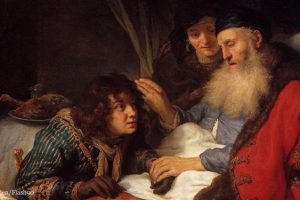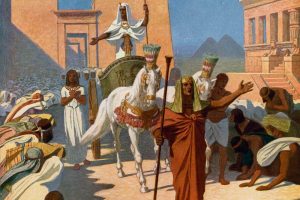King’s Paradox Reward


King’s Paradox Reward

Shalom,
First, we want to wish all of those who have been affected by the outbreak of the coronavirus to come back to normal healthy life very soon.
All of us at Ulpan-Or are now trying to help with supporting online Hebrew learning for schools, communities, and individuals sharing for free our resources during these difficult times!
Let us know if you are interested in learning more by responding to this email.
Under these conditions, I improvised on my piano an “Ani-Corona” waltz.
You are welcome to listen to it here:
https://www.youtube.com/watch?v=FlzuwWJleUM
Orly and I have initiated online group learning in our neighborhood to encourage everyone and anyone to induce meaningful time investment during these challenging times.
I was the first one to conduct this online lesson and chose to start with Rabbi Nachman’s less known short tales…
So, this time we wanted to share with you one of these tales.
Here is a short background about Rabbi Nachman.
Born in Medzhibozh, Ukraine to a distinguished Chasidic family descending from the Baal Shem Tov, Rabbi Nachman earned a reputation as an independent thinker and outspoken teacher and soon attracted his own substantial following.
Throughout his life, Rabbi Nachman faced a great deal of opposition to his unconventional ideas from many of the leading rabbis in the Chasidic world.
He was accused of arrogance, messianic pretensions, and propagating semi-heretical doctrines, and he and his Chasidim were even persecuted for their views.
In 1802, Rabbi Nachman moved to the city of Bratslav, where he suffered several personal catastrophes, including the death of his wife and several of his children, and produced the major part of his work.
He was a prolific writer, but little of his writing remains.
The most influential work attributed to him – Likutei Moharan – a compilation of his sermons on the Bible, Talmud, and Zohar – became the primary source text and spiritual guide for the Bratslav Chasidim.
However, his “Tales” may be considered the peak of his creative life, both for the originality of their form and content and for the profundity of their underlying ideas.
Many of his tales at the beginning remind us of folk stories about kings, princes, and princesses, but this usually diverse from the “original route” and end with a paradoxical conclusion…
These tales inspired many other writers and thinkers such as: Franz Kafka, Martin Buber, Yitzhak Sade Eli Wiesel and more.
Rabbi Nachman was born on the New moon of the month of Nissan (celebrated yesterday).
He contracted tuberculosis in 1810 and passed away before his fortieth birthday.
Here is one of his short (less known tales):
A Tale of Two Artists
Once there was a king who built himself a palace.

He called upon two men and commanded them to decorate it. The king divided the palace into two sections – each appointee was responsible for decorating one section – and he set a time by which they were to complete their work.

One of them began working very hard. He learned all there was to know about painting and sculpture and then decorated the section of the palace that had been entrusted to him very beautifully, with pictures of animals and birds and all kinds of beautiful images.
The second man did not take the king’s command seriously and did nothing.
The deadline for the completion of the project drew closer.

The first man had already finished his portion of the work, demonstrating great artistry.
The second man began to reflect upon his situation: he had spent all of the allotted time on vanity and emptiness and had not taken any notice of the royal command.
He began to think about what he should do, for in the few days that remained until the deadline it would be impossible to correct his mistake.
He could not study art and then decorate his portion of the palace in such a short time, for it was already very close to the date that had been set for the completion of the work.
He finally made a decision as to what to do.
He took a black herbal ointment and painted his entire section with its brilliant black.

The shine of the ointment acted like a mirror; one could see oneself in it.
He also hung a curtain in front of his section, dividing between his section and that of the other man.
When the appointed date finally arrived, the king set off to see what the men had done during this time. First, he saw the first section, which was decorated most impressively.
The way to the second section was blocked by a curtain, behind which everything looked dark, and the king could see nothing.

The second man drew the curtain aside, and the sun shone in and reflected off of all the wondrous artistry in his section, for the shining blackness reflected like a mirror.
And so all the birds that were painted in the first section, and all the other masterful illustrations, all appeared in his section too, and what the king had seen in the first section was visible also in the second.
Moreover, all the precious vessels and ornaments that the king had installed in the palace were also reflected in the second section, and whatever he would wish to add in the future would also be reflected there.

And the king was exceedingly pleased…

This story reminds us of folk stories where the “reward” given by the king to the lazy artist was the “sound of coins” paid to the diligent artist…
Or “the smell” of the food given to the one who really did the work.
In his story the king is actually pleased more by the “trick” played by the lazt artist…
Have any clue?
As opposed to his teachings in “Likutey Moharan”, Rabbi Nachman encouraged people to interpret his tales freely.
So, we do encourage you to please respond to this email with your own thoughts and interpretations.
Wishing all of you a peaceful and healthy weekend.
Shabbat Shalom,
Yoel & Orly
Many ask us for permission to redistribute our newsletters. By all means, please do feel free to forward this newsletter to anyone you wish!
Access the archive of our previous posts at:
https://www.ulpanor.com/category/blog/
Subscribe to our newsletters on our website at the bottom of the home page:
Tag:corona, rabbi nachman, tales, chasidic, chasidism






